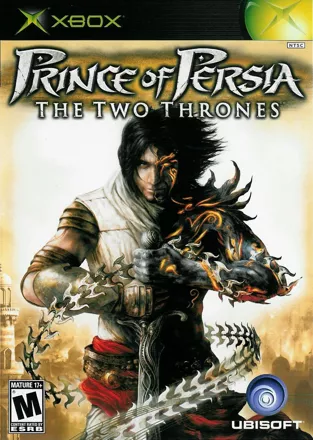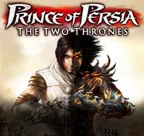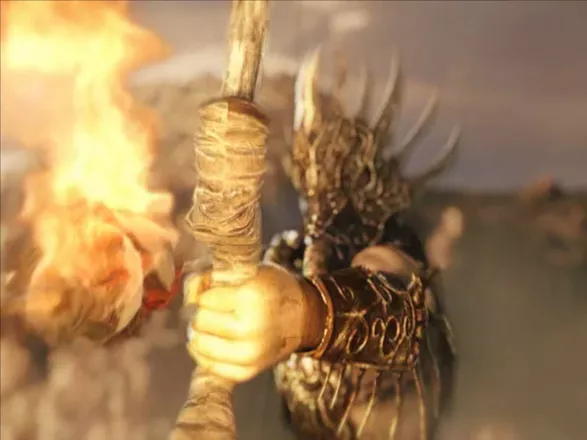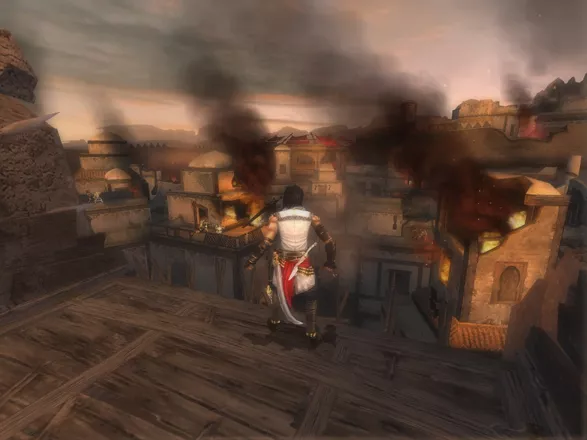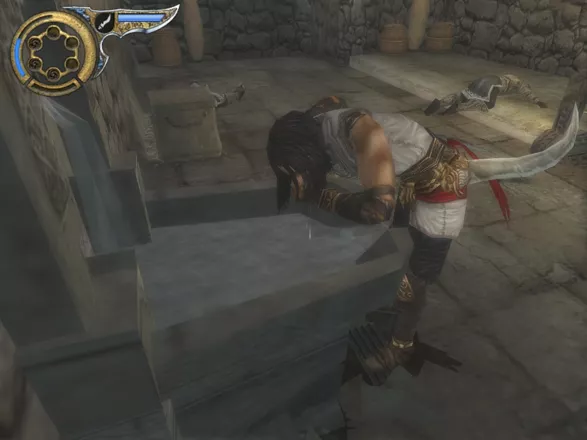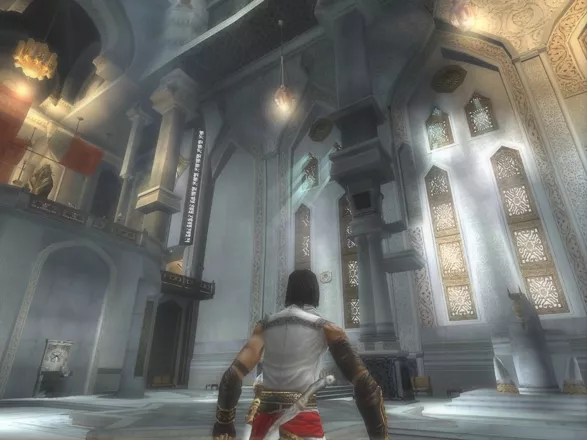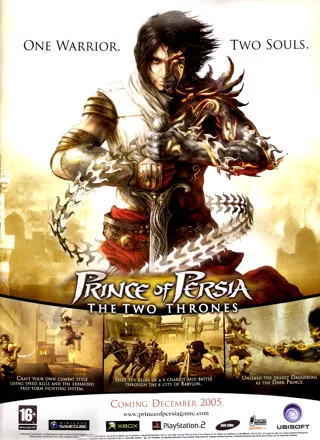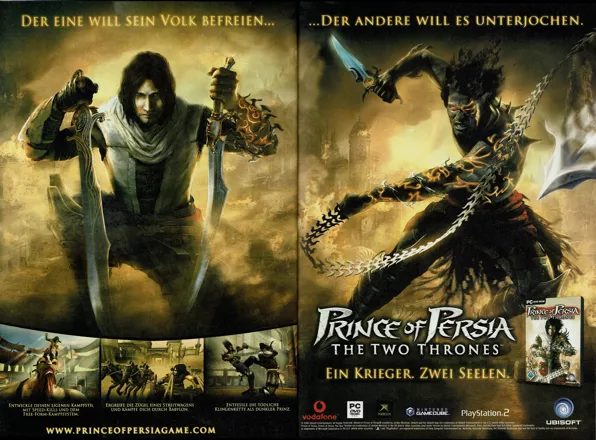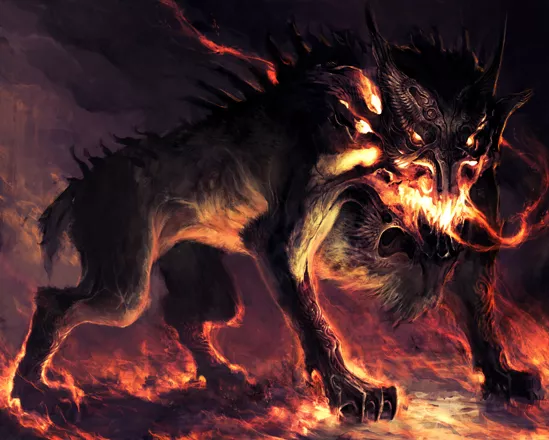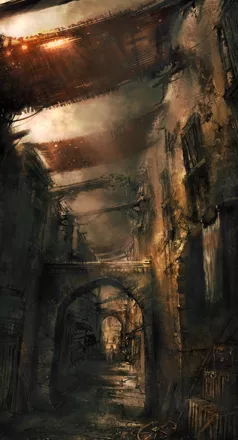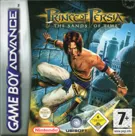Prince of Persia: The Two Thrones
Description official descriptions
After many dangerous adventures, the Prince finally makes his way home to Babylon, bringing with him his new bride Kaileena, the Empress of Time. Their hopes for a peaceful and happy future together are dashed, however, when they arrive in Persia to find the land ravaged by war. Kaileena is promptly captured and murdered by the evil Vizier, and her death unleashes the Sands of Time, from which the Vizier derives terrifying new powers.
Once again the Prince of Persia must stand to fight, but this time he will be stronger than ever, thanks to his new alter ego the Dark Prince, born of the Prince's contact with the Sands. As he fights to reclaim his kingdom from the hands of a madman, he must also battle with his own inner demons as the Dark Prince threatens to consume him entirely.
The game is very similar (in terms of fight and puzzle sequences) to the previous installments of UbiSoft's Prince of Persia trilogy: The Sands of Time and Warrior Within. There are some major innovations like the character of the Dark Prince, who possesses the main protagonist from time to time and offers him new combos and moves. There is also a new ability, called "Speed Kill", which is very effective against all opponents in the game (victims are attacked from behind and murdered in brutal and stealthy fashion).
In Prince of Persia: The Two Thrones player will explore not only the streets of Babylon, but also a ruined palace of his father, a temple and the famous Hanging Gardens.
Spellings
- Принц Персии: Два Трона - Russian spelling
- 波斯王子:王者无双 - Simplified Chinese spelling
Groups +
- Covermount: Fullgames
- Game Engine: JADE
- Gameplay feature: Time manipulation
- Games referenced in movies
- Green Pepper releases
- PlayStation 2 Greatest Hits releases
- PlayStation 2 Platinum Range releases
- Portability Engine: Cider
- Prince of Persia series
- Protagonist: Royalty
- Theme: Time travel
- Ubisoft eXclusive releases
- Weapon: Chainsaw
Screenshots
Promos
Videos
Add Trailer or Gameplay Video +1 point
See any errors or missing info for this game?
You can submit a correction, contribute trivia, add to a game group, add a related site or alternate title.
Credits (Windows version)
643 People (610 developers, 33 thanks) · View all
| Executive Producer | |
| Producer | |
| Associate Producers | |
| Creative Director | |
| Art Director | |
| Lead Programmer | |
| Project Technical Director | |
| Lead Game Designer | |
| Lead Level Designer | |
| Team Lead AI & Gameplay | |
| Animation Director | |
| Director of Photography | |
| Art Production Manager | |
| Lead Audio Designer | |
| Graphic Technical Director | |
| Animation Technical Directors | |
| Character Special Effects | |
| In-Game Cinematic Technical Director | |
| Lead QA | |
| Project Coordinator | |
| Human Resources Counsellor | |
| Creative Consultant | |
| [ full credits ] | |
Reviews
Critics
Average score: 81% (based on 82 ratings)
Players
Average score: 3.9 out of 5 (based on 92 ratings with 3 reviews)
The Good
In Prince of Persia: Two Thrones you once again play as the Prince who is returning home from the events of Warrior Within with Kaileena (if you didn’t get the best ending in POP:WW then you won’t know why) to find Babylon in flames being attacked by an enemy army you soon learn the vizier is behind it and must stop him.
This game introduces what is called Speed Kills which allows you to get a jump on the enemy but using timed button presses if successful instant death to your enemy if failed you must regularly fight the enemy.
At one point you run into Farah but she doesn’t know you cause POP: SOT didn’t happen the game also adds chariot races in which you hop in a chariot and fight enemies you try to board you while avoiding obstacles.
Another added feature is playing as the dark prince which is identical to playing as the Sand Wraith but you don’t regenerate sand.
The Bad
This game really has no problems, it fixed all the problems in every past installment.
The Bottom Line
Overall this is the best one in the series if you skipped POP: WW because it was too different from POP: SOT then this is the one to pick up A fitting end to the trilogy.
Xbox · by Classic Nigel (108) · 2006
The Good
The previous two games in the Sands of Time trilogy had their problems. Sands of Time itself had rather lackluster combat sections which mainly served to slow the game down and one of the easiest final boss battles in video games history. Warrior Within created a much better deeper and more interesting combat system and managed to improve the platforming segments as well somehow, but was bogged down by numerous bugs and rather poor characterization. Two Thrones gives us the best of both worlds.
The voice actor from the first game is back, giving us the nuanced performance of a man who has made many makes and made even more, increasing costly mistakes trying to fix them just looking for a way to finally set things right and slowly coming to terms with his responsibility for the situation and struggling against his darker impulses that dominated the previous game.
The acting is top notch, Besides the Prince himself, there's a very somber narration from The Empress of Time, who herself is far more sympathetic than she was in Warrior Within, trying to find the best possible outcome rather than just save her own hide.
I found that like Sands of Time, Two Thrones makes you care about its characters, meaning the game packs a lot of emotional punch. When you beat the final boss, the Prince hasn't just destroyed his enemy, but grown as a man. There are very few other games, especially in the action genre, that compare in this area.
Warrior Within's already greatly expanded repertoire of moves gets expanded even further here, The Prince can now do chimney climbs and has numerous places where he can stab a dagger into the wall to hang. While the vast majority of the game is spent on some variation of jumping to ledge, swinging on poles, walking balance beams and running along walls, there's so much variety in the room designs it never gets old.
Combat plays something like Warrior Within where you can hold two weapons at once and use them for numerous combos. The upgrade system has been dropped, however. You'll use the dagger of time for the entire game. This is as cool as ever, moreso, in fact thanks to the new speed kill system. Warrior Within had stealth kills, but there were hardly any opportunities to use them in the game. Here, you can sneak up on characters, then activated a sequence of timed presses to dispatch enemies in style without being attacked yourself. If you get two near each other, you can even do double speed kills.
The Dark Prince takes things even further. He adds even more new moves, notably the ability to snare things with a long chain, making for huge swinging jumps and a portable wall rope.
The chain is useful for combat as well and can be used for a variety of flashy moves. In fact, the games has a nice library of visual effects. This includes the glowing sands contained within creatures, the stylized look of the quick-kill sequences and as always for the series, impressive time effects and animation.
The previous two games had boss fights, but nothing nearly as good as what's seen here. There are only four or five, depending how you count, but each one is beautifully constructed. Prince of Persia is a platform/spatial puzzle game at heart, but the previous entries had bosses that you just hit unit they died. Here, they are far better integrated with the core mechanics of the game. The finale deserves special mention. I won't give anything away, but it's a multi-stage, multi-tiered affair with an incredible final blow.
The Bad
While they don't end your game ala Warrior Within, I did find a few glitches. Occasionally, the Prince will remain standing when he dies. If you break the bottom crate in a stack, others will hover above it. If you start blocking while standing up, often the block won't register. There's a cutscene before a double boss fight which you can't skip no matter how many times you see it. Most annoyingly, in that same fight, I kept attacking the wrong boss even though I had my left stick pushed toward the one I wanted to hit.
While the Prince himself looks great, others do not. Most notably, Farrah still has no fingers, just flesh-tone mittens. There's a cutscene where she points at something. It looks awful. I can understand this somewhat in the first game, but with years more experience and her barely even appearing outside cutscenes, you would think they could spare a few dozen polygons.
The game's main flaw is that its far less ambitious in many ways than Warrior Within. It's fairly linear, so no more open world. There's only a single ending, relatively few secrets, only four sand powers, no weapon upgrades and really nothing to do on a second playthrough. Considering how many glitches the open world caused, I'm willing to live with it, though.
In the same vein, it's far easier. Combat uses the same basic system, but you'll have to do a lot less parrying and finding openings and the speed kill system means a somewhat attentive player can avoid more than half of the Prince's fights. The Dark Prince has many fewer opportunities, but is so powerful that just whirling the chain over your head is all you'll really ever need to do. The other portions of the game are simpler as well. There were hardly any traps for the first three quarters, none of the hardest navigational bits from previous entries such as spinning rooms and point A and B were always immediately obvious and how to get between them never took much to figure out. The traps and puzzles improve greatly at the end, with the one involving moving a statue of the king across a room being a real standout.
The Bottom Line
In terms of sheer beauty of presentation and story (if not so much technical prowess, being a multiplatform game), The Two Thrones is the best entry in the Sands of Time Trilogy by far. Its only real flaw is a general lack of challenge. It will be a lot more meaningful if you've played the previous games, though. If you are a fan of the action-adventure genre at all and are looking for a more mature, reflective story than one typically finds in a platformer, you owe it to yourself to play the entire series.
Xbox · by Ace of Sevens (4479) · 2007
For This Sequel, Time Was Not Rewound Quite Far Enough
The Good
Change is often necessary for the continuation of a game series. Once-fresh ideas become stagnant and cannot help but evoke that dreaded "been there, done that" feeling in gamers. Sometimes, however, change is a very bad thing, as illustrated by the reimagined Prince of Persia franchise. After releasing the amazing and critically acclaimed Sands of Time, publisher Ubisoft inexplicably chose to pull a 180-degree turn on the series' tone. Shifting from a charming and vibrant Persian-themed fairy tale to a death metal-infused angst fest, The Warrior Within met with harsh reactions from series veterans and gaming publications. In response, Ubisoft sensed that -- much like the titular prince of the series -- they needed to roll back time so as to undo the changes in the series if they were to recapture the magic of The Sands of Time.
The result is The Two Thrones, the final chapter of the Prince of Persia trilogy. As its title suggests, the game focuses heavily on duality: the two sides of the Prince's personality, alternate timelines, and seeking to accept responsibility for and to learn from past mistakes instead of merely seeking to undo them. Strangely enough, however, there is another very important (and most certainly unintended) element of duality: Ubisoft's own inability to do the very thing that their game's main character learns to do. In trying to rewind the series in the wake of The Warrior Within's failure, Ubisoft failed to learn from that title's mistakes -- many of that game's negative elements still linger in The Two Thrones. The result is a game that tries hard to recreate the experience of its progenitor, yet doesn't quite reach back far enough in time to do so, instead feeling more like a transitional step between the first two games -- and a lacking one at that.
However, in keeping with the light/dark duality of the game, there are many things that The Two Thrones does right. Perhaps most importantly, the game attempts to recreate the high-flying, gravity-defying acrobatics of the first game in the series -- and for the most part succeeds. As the Prince makes his way through Babylon, ultimately climbing the palace to confront the game's two main antagonists (again with the duality), he must make use of a range of superhumanly dexterous abilities such as running along walls, swinging from pipes and poles, and walking along beams without losing his balance. The Two Thrones even manages to expand the Prince's repertoire of acrobatics, as he has now learned to scale walls using his dagger, as well as being able to scale up and down narrow crevasses and curtains. There is certainly no shortage of opportunities to use these skills either, as there are many skill-testing moments that are sure to leave the controller drenched in sticky sweat.
Another area in which The Two Thrones one-ups its forebears is in combat -- specifically by providing skillful players the ability to avoid combat altogether. The Two Thrones introduces the "Speed Kill," which rewards clever use of the environment and stealth by allowing players to perform instant kills upon unsuspecting foes. The screen flashes white for a brief moment, and then the player must engage in a series of timed strikes at the targets vitals (in the clichéd but effective Matrix-style "bullet time") to pull off the Speed Kill. Though frustrating at times due to unexpected shifts in camera angle (more on that later), the Speed Kill is an honest attempt on the developers' part to provide an alternative to combat, which was perhaps the biggest complaint in The Sands of Time.
And of course, there is the setting. The Two Thrones (mostly) eschews the gag-inducing angst and all-around "dark badassery" (read: juvenile crap) of its immediate predecessor in favor of a more Persian-themed backdrop akin to that of The Sands of Time. There are quite a few genuinely awe-inducing landscapes to be seen, many of them outdoor areas such as gardens or cityscapes. While climbing the palace tower, the player can look back and behold all of the city of Babylon from on high -- few games provide such a visually pleasing reward for progress.
The Bad
Unfortunately, The Two Thrones manages to retain a great number of the issues from both The Sands of Time and The Warrior Within, which seriously detracts from its enjoyability. Though much of the angst and broodiness of The Warrior Within is gone, an overdose minus half is still too much. Take the Prince for example. For much of the game, he battles against his own inner demons -- literally, in the form of the Dark Prince. An embodiment of the evil and anger within the Prince, the Dark Prince rears his ugly head many times throughout the game. Of course, the Prince himself is much more unappealing and impudent than he ever was in The Sands of Time, so there seems to be very little difference at times between the supposed "light" and "dark" halves of the two Princes -- certainly not enough to necessitate having them both in the storyline.
The Dark Prince's gameplay segments are equally redundant and frustrating. At seemingly random times throughout the game, the Prince loses control and gives in to his darker half, changing his appearance and abilities slightly. Though he is much stronger, this power is offset by a key design flaw: he loses health continually, regardless of what he does. This becomes especially frustrating during the segments in which the Dark Prince must navigate ridiculously fast-spinning trap blades. The Sands of Time was brilliant in that it allowed the player time to figure out the best course of action and, when ready, charge into the fray and skillfully make it through numerous deadly traps. By effectively enacting a short time limit upon the players, The Two Thrones's Dark Prince segments sap the fun out of working through trap-filled halls, instead becoming little more than monotonous exercises in trial-and-error. Even then, the player often has to make it through completely untouched, lest the Dark Prince collapse immediately after successfully running the gauntlet on attempt number twelve or so. Sure, the Dark Prince can replenish his health by -- of all things -- breaking open clay pots and wicker baskets, but apart from being completely unintuitive (a word that could not easily be used in describing any aspect of The Sands of Time), this does little to remedy the underlying design flaw.
The Dark Prince can also replenish his health by killing foes, which leads to the next major flaw of the game: the combat system. In keeping with the "transitional" feel, The Two Thrones's combat feels like a bridge between the dull combat of The Sands of Time and the versatile yet overly complex "Free-Form Combat" of The Warrior Within. In other words, it is the worst of both worlds. Though the Prince can utilize multiple combos with one or two weapons, most enemies can be beaten by repeatedly mashing the square and triangle buttons. Likewise, the Dark Prince can easily kill any enemy simply by twirling his chain in a circle above his head. Though the mixture is certainly Ubisoft's attempt to correct its past mistakes in the series via compromise, it effectively makes the Free-Form Combat system redundant. The Sands of Time's combat was far from perfect, but it got the job done -- if Ubisoft wanted to rewind time on the combat system, they should have just gone back all the way instead of stopping halfway, admitting both to consumers and to themselves that the series is not about combat.
Their reluctance to do so, however, leads to additional problems, such as wonky boss battles. The Sands of Time proved that games don't need to have traditional "bosses" to be enjoyable, providing one really moving and engaging battle at the very end of the game. The Two Thrones takes on a dual philosophy yet again in this regard, providing some bosses in order to justify the inclusion of the Free-Form Combat system. As a result, there are some truly irritating button-mashing marathons masquerading as "boss fights." (The final boss battle, a rematch with the Vizier from the first game, is particularly aggravating.) Furthermore, all of the boss battles require the use of the Speed Kill mechanism in some capacity, effectively stripping down a cool element of player choice to yet another rote button tapping exercise.
The game's puzzles and platforming zones are equally lacking for the most part, with a few exceptions. There are some genuinely hair-raising segments, but for each one of those there are two very straightforward and easily navigable areas. Part of The Sands of Time's brilliance was that it required a bit of thought and strategy in planning out how to clear an area. In The Two Thrones, however, players often will have no problem figuring out where to go or how to get there, simply jumping around and running along walls to get from point A to point B. The sections that do end up being difficult are not so because of clever design, but rather because the indoor areas retain the drab browns and darkness of The Warrior Within to such a degree that it is almost impossible to see the next ledge or crack in the wall that the Prince must jump to. Combine this element with a severely spastic camera, and disaster is certain to ensue.
Furthermore, the save points do not provide visions to guide the player like the ones in The Sands of Time. In fact, the save points no longer exist -- there are only fountains, which both replenish health and allow the game to be saved. Though this may seem trivial, it is actually indicative of perhaps the biggest issue with the game: a lack of verisimilitude and integration. Everything in the series's first entry was integrated seamlessly -- game conventions such as save points, health replenishment, and the like had a rational and believable reason for existence. In The Two Thrones, they just feel like the videogame conventions that they are instead of like part of a larger world.
The storyline is also lacking in power and believability. Sands of Time had its moments, but felt more like a Persian tale than a serious exercise in storytelling; The Two Thrones's dual tones give it a greater air of seriousness, which backfires. The player is supposed to believe, for example, that the Prince is maturing and accepting responsibility for his past mistakes instead of merely trying to undo them. There is little to cause anyone to believe, however, that the Prince is actually doing so. Likewise, though bringing some of the other games' characters back was a nice touch, it is hardly believable. In fact, they become more redundant than anything else (especially Kaileena). This redundancy is further reinforced by the fact that dialogues and cutscenes are unskippable, so if segments have to be redone (I'm looking at you, Dark Prince segments), the player must endure the same lines way too many times. Furthermore, without giving too much away, the story's ending is like the ultimate slap in the face. Though not quite as insulting as the endings of other sequels (Knights of the Old Republic II, you know what I'm talking about), The Two Thrones's ending is both cheap and a final testament to the game's overall redundancy.
The Bottom Line
The numerous flaws of The Two Thrones by no means make it a bad game -- far from it. It is merely a disappointing and ultimately redundant one in comparison to its progenitor, The Sands of Time. For many fans of the Prince of Persia series, Ubisoft's decision to rewind the series back to its roots after the badly-received Warrior Within was excellent news, but perhaps brought with it impossible expectations. Then again, maybe Ubisoft was simply unwilling to do the same kind of self-reflection that the Prince is supposedly doing during the game itself, refusing to admit that The Warrior Within was (for most fans of the original) a huge mistake. They instead tried to rewind the series back enough to keep some elements of the second game while being as close to the first as possible. In so doing, they truly did emphasize the duality of two thrones: that of The Sands of Time's Contender (for "Game of the Year" awards from numerous gaming publications), and that of The Two Thrones's Pretender (for trying to be the original, but failing).
PlayStation 2 · by prymusferal (23) · 2008
Trivia
European version
In the European version, sand monsters can't be cut in half or lose their head.
References
Shortly after meeting Farah for the first time, the Prince talks to himself, wondering why she doesn't remember him (from the first game). The Dark Prince responds to him that they are better off without her: "Perhaps a few arrows in the back might remind you."
This is a reference to the first game that the developers stuck in. Farah was notorious for "helping" in combat by shooting arrows at everyone, including you.
Or as others have called it, she uses a "Bow of Friendly Fire."
Wii version
Unlike the other platforms, the Wii version has an ESRB Teen rating because the bloody sequences have been toned down. Enemies bleed sand instead of blood.
Information also contributed by STU2.
Analytics
Upgrade to MobyPro to view research rankings and price history! (when applicable)
Related Sites +
-
Prince of Persia: The Two Thrones
Official game website -
Two Princes, One Destiny
An Apple Games article about the Mac version of Two Thrones. -
Zarf's Mini-Review
A mini-review of the PlayStation 2 version of The Two Thrones by Andrew Plotkin (December, 2005).
Identifiers +
Contribute
Are you familiar with this game? Help document and preserve this entry in video game history! If your contribution is approved, you will earn points and be credited as a contributor.
Contributors to this Entry
Game added by UV.
PlayStation 3 added by Charly2.0. PSP added by Sciere. Wii, Macintosh added by Kabushi.
Additional contributors: Unicorn Lynx, Jeanne, tarmo888, Sciere, Kabushi, Ghost Pirate, Jacob Gens, Zeppin, Klaster_1, Eltahriel, OFF, Patrick Bregger, Plok.
Game added December 15, 2005. Last modified January 2, 2025.


